Dairy Nutrient Management and Groundwater Quality
Funding:
Central Valley Regional Water Board
Dairy CARES
California Dairy Research Foundation
UC Sustainable Agriculture Research and Education Program
UC Analytical Laboratory
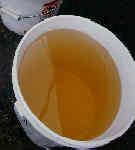
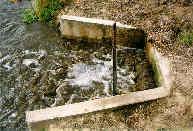
- implement a groundwater monitoring program to characterize shallow groundwater quality underneath a number of cooperating dairies in central California,
- assess the occurrence and fate of nitrogen, salts, microbes, pharmaceuticals, and naturally occurring steroid hormones across the various components of a dairy facility
- develop specific recommendations for improvements in dairy nutrient management that are likely to have significant impact on groundwater quality,
- develop strategies to improve current groundwater quality,
- educate regulatory agency staff and dairy operators about potential pathways of manure nutrients in the subsurface below dairies and about their potential role in safeguarding ground water quality.
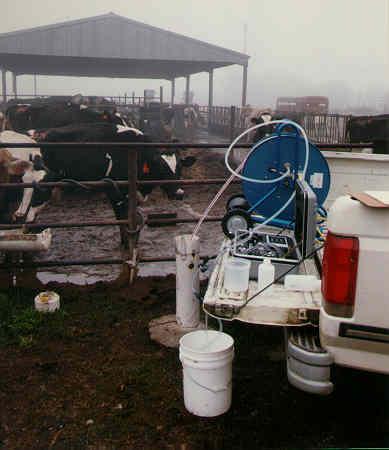
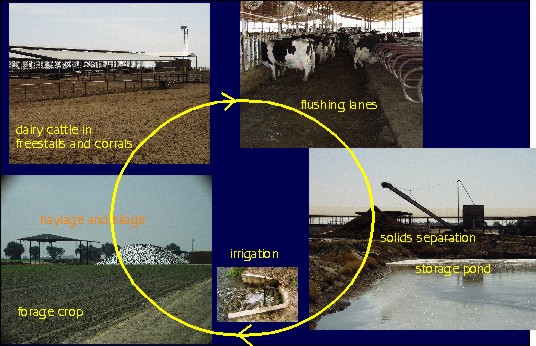
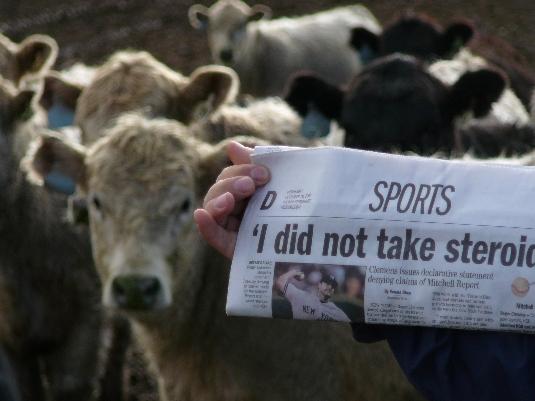
Publications and Reports:
Harter, T., N. Watanabe, X. Li, E. R. Atwill, and W. Samuels, 2014. Microbial groundwater sampling protocol for fecal-rich environments, Groundwater, doi:10.1111/gwat12222 (open access).
Harter, T., M. Young, and K. Lockhart, 2013. Nitrate and salinity in shallow groundwater beneath dairy farms in the Central Valley, California. Task Report 1. SWRCB Agreement Number 04-184-555. Department of Land, Air, and Water Resources. University of California, Davis. 28 pages.
Young, M., C. Kendall, K. Lockhart, B. Esser, T. Harter, 2013. Using nitrate and water isotopes to evaluate groundwater quality beneath dairy farms in California. Task Report 2. SWRCB Agreement Number 04-184-555. Department of Land, Air, and Water Resources. University of California, Davis. 38 pages.
Lockhart, K., A.M. King, T. Harter, 2013. Identifying sources of groundwater nitrate contamination in a large alluvial groundwater basin with highly diversified intensive agricultural production. Task Report 3. SWTCB Agreement number 04-184-555. Department of Land, Air, and Water Resources. University of California, Davis. 41 pages.
Young, M., C. Kendall, K. Lockhart, T. Harter, 2013. Stable isotopes as tracers of sources and processes related to nitrate distributions in domestic supply wells in the San Joaquin Valley, California. Task Report 4. SWRCB Agreement Number 04-184-555. Department of Land, Air, and Water Resources. University of California, Davis. 31 pages.
Li, X., E.R. Atwill, and T. Harter, 2013. Microbial pathogen risks to dairy groundwater. Task Report 5. SWRCB Agreement Number 04-184-555. Department of Land, Air, and Water Resources. University of California, Davis. 13 apges.
Harter, T., J. H. Viers, D. Liptzin, T. S. Rosenstock, V. B. Jesnen, A. D. Hollander, A. McNally, A. M. King, G. Kourakos, E. M. Lopez, N. DeLaMora, A. Fryjoff-Hung, K. N. Dzurella, H. Canada, S. Laybourne, C. McKenney, J. Darby, and J. F. Quinn, 2013. Dairies and other sources of nitrate loading to groundwater. Task Report 6. SWRCB Agreement Number 04-184-555. Department of Land, Air, and Water Resources. University of California, Davis. 103 pages.
Boyle, D., A. King, G. Kourakos, K. Lockhart, M. Mayzelle, G. E. Fogg, and T. Harter. 2013. Long-term effects of dairies on groundwater nitrate. Task Report 7. SWRCB Agreement Number 04-184-555. Department of Land, Air, and Water Resources. University of California, Davis. 86 pages.
Watanabe, N., B. A. Bergamaschi, K. A. Loftin, M. T. Meyer, and T. Harter, 2010. Use and environmental occurrence of antibiotics in freestall dairy farms with manure forage fields, Environ. Sci. Technol., 2010, 44 (17): 6591–6600, DOI: 10.1021/es100834s. (free public access).
VanderSchans, M. L., T. Harter, A. Leijnse, M. C. Mathews, R. D. Meyer, 2009. Characterizing sources of nitrate leaching from an irrigated dairy farm in Merced County, California, J. of Contam. Hydrology 110:9-21, (pdf file for personal use only).
Harter, T., 2009. Agricultural impacts on groundwater nitrate, Southwest Hydrology 8(4):21-23 (Jul/Aug 2009) . (free public access)
Horn, J. and T. Harter, 2009. Domestic well capture zone and influence of the gravel pack length. Ground Water 47(2):277-286. (pdf file for personal use only)
Watanabe, N., T. Harter, and B. A. Bergamaschi, 2008. Environmental occurrence and shallow groundwater detection of the antibiotic Monensin from dairy farms. J. Environ. Qual. 37:S-78–S-85 (2008). doi:10.2134/jeq2007.0371. (pdf file for personal use only)
Chomycia, J.C., P.J. Hernes, T. Harter, and B.A. Bergamaschi, 2008. Land management impacts on dairy-derived dissolved organic carbon in ground water. J. Env. Qual. 37(2), 333-343. doi:10.2134/jeq2007.0183.
Harter, T., E.R. Atwill, L.L. Hou, B.M. Karle, and K.W. Tate, 2008. Developing risk models of Cryptosporidium transport in soils from vegetated, tilted soilbox experiments. J. Env. Qual. 37(1), 245-258. doi:10.2134/jeq2006.0281.(pdf file for personal use only)
Harter, T. (ed.), 2007. Groundwater Quality Protection: Managing Dairy Manure in the Central Valley of California. University of California Agriculture and Natural Resources Publication 9004(Downloadable from the web; also see Chang et al., 2005, below), 178 pp.
Singleton, M. J., B. K. Esser, J. E. Moran, G. B. Hudson, W. W. McNab, and T. Harter, 2007. Saturated zone denitrification: Potential for natural attenuation of nitrate contamination in shallow groundwater under dairy operations. Env. Sci. & Technol. 41 (3), 759-765.
Searcy, K.E., A. I. Packman, E. R. Atwill, and T. Harter, 2006. Deposition of Cryptosporidium oocysts in streambeds. Applied and Environmental Microbiology, 72(3):1810-1816. (pdf file for personal use only)
Chang, A., T. Harter, J. Letey, D. Meyer, R. D. Meyer, M. Campbell-Mathews, F. Mitloehner, S. Pettygrove, P. Robinson, R. Zhang, 2006. Managing Dairy Manure in the Central Valley of California; University of California Committee of Experts on Dairy Manure Management Final Report to the Regional Water Quality Control Board, Region 5, Sacramento, June 2005. 178 pp. (pdf file for personal use only)
Harter, T., Y. S. Onsoy, K. Heeren, M. Denton, G. Weissmann, J. W. Hopmans, W. R. Horwath, 2005. Deep vadose zone hydrology demonstrates fate of nitrate in eastern San Joaquin Valley, California Agriculture 59(2):124-132. (pdf file for personal use only)
Harter, T. and J. Menke, 2005. Cow numbers and water quality - is there a magic number? A groundwater perspective. (revised from: Harter T., 2004, Proceedings, National Alfalfa Symposium, San Diego, December 13-15, 2004. 13 pages). (pdf file for personal use only)
Kolodziej, E. P., T. Harter, D. L. Sedlak, 2004. Dairy wastewater, aquaculture, and spawning fish as sources of steroid hormones in the aquatic envionrment, Env. Science and Technol. 38, p. 6377-6384. (pdf file for personal use only)
Harter, T. and S. Talozi, 2004. A simple, inexpensive dialysis sampler for small diameter monitoring wells, Ground Water Monitoring & Remediation, Fall 2004, 97-105. (pdf file for personal use only)
Campbell-Mathews, 2004. Principles of recycling dairy manures through forage crops. Proceedings, National Alfalfa Symposium, San Diego, December 13-15, 2004. 8 pages. (pdf file for personal use only)
Harter, Thomas, H. Davis, Marsha C. Mathews, Roland D. Meyer, 2002. Shallow groundwater quality on dairy farms with irrigated forage crops, Journal of Contaminant Hydrology 55 (3-4), pp. 287-315. (pdf file for personal use only)
Harter, T., R. D. Meyer, M. C. Mathews, 2002. Nonpoint source pollution from animal farming in semi-arid regions: Spatio-temporal variability and groundwater monitoring strategies; in: Ribeiro, L. (Ed.), 2002, Future Groundwater Resources at Risk, Proceedings of the 3rd International Conference, Lisbon, Portugal, June 2001; pp. 363-372. (pdf file for personal use only)
Mathews, M. C., E. Swenson, T. Harter, R. D. Meyer, 2001. Matching dairy lagoon nutrient application to crop nitrogen uptake using a flow meter and control valve. ASAE Paper Number 01-2105, 2001 ASAE Annual International Meeting, Sacramento, CA, July 30-August 1, 2001. (pdf file for personal use only)
Harter, T., M. C. Mathews, R. D. Meyer, 2001. Effects of dairy manure nutrient management on shallow groundwater nitrate: a case study. ASAE Meeting Presentation, ASAE Paper Number 01-2192, 2001 ASAE Annual International Meeting, Sacramento, CA, July 30-August 1, 2001; 2001. (pdf file for personal use only)
Harter, T., H. Davis, M. C. Mathews, R. D. Meyer, 2001. Monitoring shallow groundwater nitrogen loading from dairy facilities with irrigated forage crops. ASAE Meeting Presentation, ASAE Paper Number 01-2103, 2001 ASAE Annual International Meeting, Sacramento, CA, July 30-August 1, 2001. (pdf file for personal use only)
Brune, D. E., C. M. Drapcho, D. E. Radcliff, T. Harter, R. Zhang, 1999. Electromagnetic survey to rapidly assess water quality in agricultural watersheds, ASAE Paper No. 99-2176 ASAE 1999Annual International Meeting, ASAE, 2950 Niles Rd., St. Joseph, MI 49085-9659.
Harter T., R. D. Meyer, M. Campbell-Mathews, 1999, Shallow groundwater quality under dairies in Merced and Stanislaus County, Proceedings, 1999 California Plant and Soil Conference, California Chapter of American Society of Agronomy, pp. 122-127.
Campbell-Mathews, M., R. D. Meyer, T. Harter, 1999. Using dairy lagoon water to replace commercial fertilizer, Proceedings, 1999 California Plant and Soil Conference, California Chapter of American Society of Agronomy, pp. 133-138.
Lowry, P., Hilmar Ground Water Study, CVRWQCB Files. 56+ pp., 1987.
Page, R. W., G. O. Balding, Geology and Quality of Water in the Modesto-Merced Area, San Joaquin Valley, California, U. S. Geological Survey Water Resources Investigations 6-73, 85 pp., 1973.
Video-Podcasts / Audio-Podcasts / Blogs
UC Groundwater Scientist Studies Aquifers Beneath Valley Dairies
What happens to antibiotics used on dairy farms? (go to 15:30min)
Archived information:
Dairy Environmental Quality related websites
Research project: Integrating Forage Production with Dairy Manure Management
